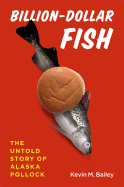
The pollock fishing industry in the Bering Sea yields more than a billion dollars' worth of fish each year--much of it headed for the frozen food sections of supermarkets or between fast-food sandwich buns. In Billion-Dollar Fish, biologist Kevin M. Bailey shows us how the story of the pollock is as much about fishing rights as about the science of fisheries. Still, "from the point of view of the fish," he notes, "the problem is not who catches them, but how many are caught."
For centuries, the lowly groundfish pollock had no market; it was merely "one of the best baits known for cod." But when the cod population dwindled, the relatively easy-to-catch pollock became a lucrative substitute--so much so that pollock fishing became the basis of international wrangling among the Japanese, Russians and Americans. It was also the source of ongoing political squabbles in the United States among large fishing companies, environmentalists, marine biologists and coastal communities. As Bailey points out, however, "biology is messy"--no branch of it more than the ecology of fisheries. How many fish are really in the sea? How many die off "naturally" and how many through fishing?
As Bailey blends science with competitive fighting over a substantial pile of money, he tells a pretty good story. Never boring or entangled in scientific jargon, Billion-Dollar Fish practically makes pollock fishing out to be The Old Man and the Sea. --Bruce Jacobs, founding partner, Watermark Books & Cafe, Wichita, Kan.

